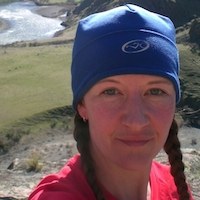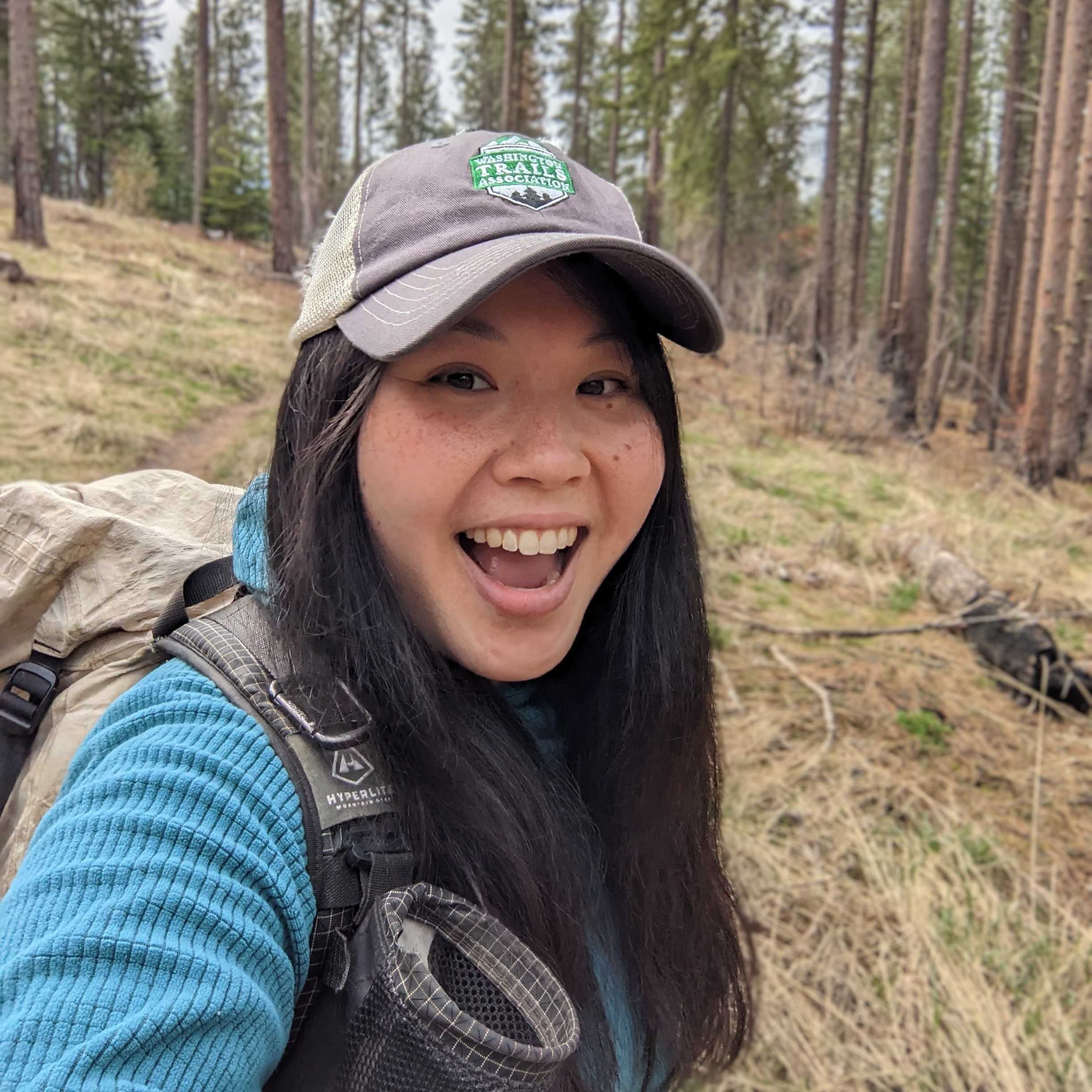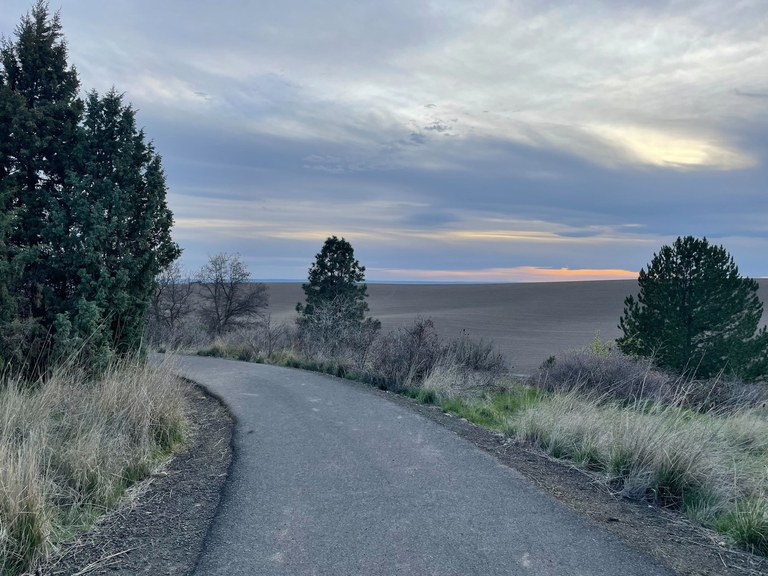Hike the State 2022: 15 WTA Staff-Picked Trails to Hike Around the State This Summer
Get excited for summer with new-to-you hikes to discover! Five WTA staffers reveal three of their favorite hikes from every corner of the state. There's something here for everyone, and some great resources to help you get your summer hiking off to a great start.
If you try any of these hikes, we'd love to hear about it in a trip report. Or if you can't make it out on trail right now, save them to your My Backpack account for later. By saving hikes to your backpack, our hike recommender tool can help you find even more personalized hike suggestions.
If you find these WTA resources helpful, consider becoming a member and supporting our work. Thank you for investing in the future of trails.
Holly's Picks
 Holly Weiler (she/her)
Holly Weiler (she/her)
Role at WTA: Eastern Washington Regional Coordinator
About Holly: Holly got her introduction to trail work through Conservation Northwest, and has been with WTA for 9 years. She is an avid runner & backpacker who also hikes out trash she finds on trail. She once hiked with a trashed cast iron pot 7 miles! But hikers like Holly are few and far between. It's important to always pack out what you pack in. Please see WTA's Leave No Trace tips page to learn more!
Thunder Creek
Location: Northeast Washington –- Metaline Falls Area
Length: 13.4 miles, roundtrip
Elevation Gain: 2500 feet

Photo by trip reporter Kylems
This loop route within the far northeast corner’s Salmo Priest Wilderness can serve as either a long day hike adventure or a short one-night backpack trip. The hike starts at Thunder Creek Trailhead, just across the road from the historic Gypsy Meadows, a former Civilian Conservation Corps camp turned popular camping destination in the Colville National Forest.
The early miles of the hike cross an old clear-cut that extends nearly to the Salmo Priest Wilderness boundary, climbing via a converted logging road through a recovering forest. At approximately the 3-mile mark, the trail enters the dense inland temperate rainforest and contours through gorgeous old-growth trees while continuing to ascend to the Shedroof Divide, topping out at around 6000’ elevation. While a sighting would be rare indeed, this forest is home to grizzly bears and until recently, provided habitat for woodland caribou (and will hopefully see their reintroduction soon).
Turn north on the Shedroof Divide, hiking one of the prettiest sections of this long trail through the heart of the Salmo Priest Wilderness. The trail skirts around Thunder Mountain and offers spectacular views both northwest toward Canada, as well as southeast to the Idaho Selkirks. Upper and Lower Priest Lake are frequently visible in the drainage to the east. Continue northbound 6 miles to the junction with the Shedroof Cut-off Trail, which descends 1.8 miles to return to the road. A short downhill road walk of approximately 0.5 miles brings hikers back to the starting trailhead to complete the loop.
> Plan your hike to Thunder Creek using WTA’s Hiking Guide
East Butte and West Butte
Location: Southeast Washington –- Dayton/Pomeroy Area
Length: 20 miles
Elevation Gain: 4500 feet

Photo by trip reporter RichP
There are many options for combining exploration of the East and West Butte Creek Trails, which start about 6 miles apart from each other but join deep in the canyons formed by their respective creeks. This is a landscape shaped by both water and fire, where the drawbacks include a long list of maintenance needs but the benefits are solitude and spectacular wildflower displays.
The East Butte Creek Trail is located at the Teepee Trailhead (NW Forest Pass required), which is a shared access point for the popular Oregon Butte Trail. The West Butte Creek Trail is located near the historic (and rentable) Godman Guard Station and Godman Campground, either being excellent options for camping nearby.
The preferred route to combine both trails is to start on the West Butte Creek Trail, which wastes no time in dropping into the steep canyon. The wildflowers are spectacular right from the start, and the trail crosses into the Rainbow Creek Research Natural Area, the existence of which hints at how unique this ecosystem is. There are campsites at Rainbow Creek (4-mile mark) and the junction between West and East Butte Creek (10-mile mark). Complete the thru-hike by ascending East Butte Creek, which offers plentiful access to water in the form of many water crossings along the trail.
This trail system has seen impacts from both the 2015 Grizzly Complex Fire and the 2021 Green Ridge Complex but has also received the benefit of multiple work parties by both Washington Trails Association and Back Country Horseman of Washington in recent years, including an upcoming WTA Backcountry Response Team trip.
Pro Tip: Visitors who are interested in hiking or backpacking the full loop would need to consider a means of shuttle between the two trailheads, or else will face a road walk of approximately 6 miles to close the loop.
> Plan your hike using WTA's Hiking Guide: East Butte Creek | West Butte
Mica Peak
Location: Eastern Washington -– Spokane Area
Length: 8.4 roundtrip
Elevation Gain: 2100 feet

Photo by Holly Weiler
Mica Peak Conservation Area was acquired by Spokane County Parks in 2013 through the Conservation Futures funding program. Initially a blank canvas of former mining and logging land, a County Parks-led planning process and deep investment by several Spokane-area trail nonprofits have led to the creation of a robust multi-use non-motorized trail system. One of the highlights of this system is the California Creek Trail, the main multi-use and bi-directional trail that climbs from the Belmont Road Trailhead to the upper reaches of the County-owned property, and which offers the best connection point for continuing the trek to the adjacent Liberty Lake Regional Park.
Start the hike up California Creek by bearing right on the double track behind the gate at the trailhead. The early miles ascend through an adjacent Department of Natural Resources (DNR) property via a trail easement. Watch for trail signage installed by Spokane County Parks at major junctions, as the California Creek Trail intersects and crosses several DNR logging roads as it climbs.
California Creek Trail intersects and joins Moonshine Trail (double-track) at the northeast boundary of the DNR property. The trails converge for about a half mile before California Creek turns left at a marked intersection, continuing just under a mile on a “spine trail” maintained for County Parks vehicle access. At the next intersection, turn right and climb the highest reaches of California Creek on a WTA-constructed single track, with sweeping views that reach from Idaho to the east, the entirety of the Spokane Valley to downtown Spokane, and the farmlands on the Palouse to the southwest. The trail is fantastic for both spring wildflowers and fall colors, and can even offer challenging snowshoeing, Nordic skiing, and backcountry skiing terrain in the winter.
> Plan your hike to Mica Peak using WTA’s Hiking Guide
Tiffany's Picks
 Tiffany Chou (she/her)
Tiffany Chou (she/her)
Role at WTA: Communications Coordinator
About Tiffany: Tiffany joined WTA this year (2022) after completing our Emerging Leaders Program this spring. She was a famous name here at WTA already though, having won the coveted Most-Miles-Hiked by a long-distance hiker in WTA's annual Hike-a-Thon while she was a Southbound PCT thru-hiker in 2019.
Pacific Crest Trail (PCT) - Hart's Pass to Holman Pass
Location: North Cascades -– Pasayten
Length: 14.4 miles, one-way
Elevation Gain: 6900 feet
Note: This hike traverses between PCT mile markers 2623.0 - 2636.5 northbound, 17.1 - 30.6 southbound

Photo by Tiffany Chou
These 14 miles from Hart's Pass to Holman Pass on the Pacific Crest Trail are some of the last for northbound PCT thru-hikers, and the very first for most southbound thru-hikers, as southbounders usually start at Hart's Pass, hike up to the northern terminus, and only then begin heading south. These are some of the most memorable miles from my entire PCT thru-hike, not only because they were the first miles on my journey, but also because of their beauty and difficulty.
This trek is a thigh-burner as you ascend and descend pass after pass, but you’ll be rewarded with breathtaking views. The trail takes you both below and at the cusp of the tree line at various points, which changes the scenery. In the summer, wildflowers dot the grass around you.
The trail is easy to follow, as the PCT tends to be well-marked and maintained. There is dispersed camping along the trail, with many sites doubling as incredible vantage points of the North Cascades. It’s a long drive to Hart’s Pass for most Washingtonians, but if views, solitude and a challenge are what you’re seeking, this just might be just the hike you’re looking for.
Pro tip: If you’d like to extend your hike another (tough!) 17 miles, you can hike further north to the PCT Northern Terminus monument on the US-Canada border. (Be sure to stop and turn around there; you aren’t allowed to enter Canada along the PCT without a Canada Entry Permit!)
> Plan your hike to Pacific Crest Trail (PCT) - Hart's Pass to Holman Pass using WTA’s Hiking Guide
Dosewallips River Road
Location: Olympic Peninsula -- Hood Canal
Length: 13.0 miles, roundtrip
Elevation Gain: 1200 feet

Photo by Tiffany Chou
This trail is an old forest road that got washed out a mile in, leading to a couple of now abandoned car campgrounds. As such, it makes for a wonderful beginner's backpacking trip as the trail is wide and relatively flat throughout. More advanced hikers will likely also find something special in this trail.
Elkhorn Campground is 2.7 miles in and has plenty of flat camping spaces, picnic tables, firepits and easy access to the river. 6.5 miles from the trailhead is Dosewallips Campground, which has all the same features as Elkhorn but also has food storage lockers.
The deserted car campgrounds are a sight to behold. As mentioned, they’re well-equipped for campers with many amenities. But because the campgrounds haven’t been accessed by car since the washout, they’re also covered in moss and vegetation, making for somewhat spooky and intriguing campsites, unlike many you’ve probably been to.
Pro tip: If you’re searching for a challenge, take the side trail up to Lake Constance. The trailhead is about 5 miles in on the Dosewallips River Road. It’s an incredibly steep climb along Constance Creek, requiring navigation through heavily burned areas and thick forest where the trail is difficult to find. You’ll likely have to use your hands at times to climb up nearly vertical sections. But the lake itself is magnificent, and the feeling of accomplishment is even more so.
> Plan your hike to Dosewallips River Road using WTA’s Hiking Guide
South Fork County Park
Location: Puget Sound and Islands -- Bellingham Area
Length: 1.5 miles, roundtrip
Elevation Gain: 22 feet

Photo by Tiffany Chou
This family-friendly loop trail isn’t a far drive from Bellingham, and is a great place to hike, run or even take your horse! Because most of the trail is also an equestrian trail, it is relatively flat and very wide. There is a huge field in the middle of the loop, a perfect spot for a picnic, snack break or afternoon in the sun.
The very first part of the trail is in a small forest, with heavy vegetation around you; this part of the trail is exclusively for hikers and bikers. Once you exit this short section, the trail opens up wide and you’ll be able to see nearby peaks on a clear day.
With plenty of paved parking and amenities at the trailhead, an easy-to-navigate grassy trail and lots of open space, South Fork County Park is an easy choice if you’re looking for something not too far from civilization to get some fresh air.
> Plan your hike to South Fork County Park using WTA’s Hiking Guide
Jessi's Picks
 Jessi Loerch (she/her)
Jessi Loerch (she/her)
Role at WTA: Washington Trails Editor
About Jessi: Jessi is the editor of Washington Trails (members will be familiar with our quarterly magazine) and has been with WTA for five years now. She moved to the Olympic Peninsula two years ago and is making Seattle-based staff jealous of her after-work outdoor adventures!
Dungeness Spit
Location: Olympic Peninsula -- North Coast
Length: 11 miles, roundtrip
Elevation Gain: 130 feet

Photo by trip reporter Eve
Dungeness Spit is a charming hike to a beach in Dungeness National Wildlife Refuge. It’s a hike that, depending on what you’re in the mood for, can be many things. It could be a short stroll through the woods with a nice view of the beach. Or you could walk down to the beach and enjoy a picnic and let your kids play on the logs and in the sand. Or, if you want to make a day of it, you can trek to the New Dungeness Lighthouse at the end of the long, thin sand spit.
Begin your hike at the parking lot — note that you’ll need $3 to park and that dogs are not allowed. You’ll pass through the cool, lush forest before coming to wide views looking out over the spit and the Strait of Juan de Fuca. Next, drop down to the beach. Kids love playing on the logs and there’s often wildlife to watch, including birds and sea life. If you have binoculars, you’ll want to bring them. On the beach, you can wander as far as you like. Just keep to the north, the south side is closed for wildlife habitat.
Pro Tip: If you make it all the way out to the lighthouse while it’s open, you can tour the museum and even see the light. There is also fresh water and picnic tables available.
> Plan your hike to Dungeness Spit using WTA’s Hiking Guide
Ebey Waterfront Trail
Location: Puget Sound and Islands -- Marysville
Length: 3.2 miles
Elevation Gain: minimal

Photo by Jessi Loerch
Ebey Waterfront Trail is a lovely little ADA-accessible trail along the Snohomish River in Marysville. It’s paved the whole way and there’s a playground and restrooms in the parking area. It’s a great place for a walk if you live nearby, or to stretch your legs if you're passing through. It’s also a good option for scooters or bikes, especially for young kids.
The trail travels upriver from the parking lot. After passing under an overpass, the route is flat all the way. You’ll get good views of the river, as well as the Cascade and Olympic mountains. You’re also likely to spot wildlife, in particular birds.
The trail passes along the Qwuloolt Estuary, which had been cut off from the flow of saltwater for more than 100 years. But in August of 2015, a levee was breached and the area was returned to a more natural habitat. That project was led by the Tulalip Tribes in partnership with various government agencies.
Pro Tip: There are picnic tables at the end of the trail, and occasional benches along the way. Going in the evening is particularly nice when the low light makes for excellent reflections on the water.
> Plan your hike to Ebey Waterfront Trail using WTA’s Hiking Guide
Striped Peak
Location: Olympic Peninsula –- North Coast
Length: 7.5 miles, roundtrip
Elevation Gain: 850 feet

Photo by WTA
After years of work, WTA volunteers recently completed a new section of trail at Striped Peak to make a beautiful loop, with gorgeous views of the Strait of Juan de Fuca. And Striped Peak is at the Salt Creek Recreation Area, which offers year-round camping, a playground, open play fields, picnicking and beach access, with fabulous tidepools.
Begin your hike at the trailhead, which is right after the entrance to Salt Creek and easy to spot. Take note that this is a multi-use trail, so you might be sharing it with horses and mountain bikers.
You’ll start on a wide, relatively flat trail before the trail narrows a bit and begins rolling up and down through the forest, with peek-a-boo views of the saltwater. Watch for a junction, which is where you’ll finish after the loop. Keep left here. If you have little kids, keep them nearby in this section, which has some exposure. After just under a mile, watch for a turn-off down to a sweet little cove. If the tide is out far enough, you can scramble over some logs to enjoy the beach.
Back on the main trail, you’ll continue climbing up through the forest and eventually begin to loop back toward the west. Enjoy the stellar views and a couple of benches along the way. Watch for a sign pointing you to Striped Peak. It’s worth the short detour to enjoy wide views. You’ll finish your hike up by dropping down through the forest before joining back up with the original trail just before the trailhead.
Pro Tip: Check out WTA's resources for hiking with children before your next family adventure!
> Plan your hike to Striped Peak using WTA’s Hiking Guide
Grady's Picks
 Grady Olson (he/him)
Grady Olson (he/him)
Role at WTA: Development Operations and Analytics Manager
About Grady: Grady found WTA through trail maintenance work parties and joined the organization as staff 5 years ago. He has explored much of the Western U.S. and logs some major miles as a trail runner!
Bennington Lake
Location: Eastern Washington -- Palouse and Blue Mountains
Mileage: 20 miles of trails
Elevation Gain: minimal

Photo by Rachel Wendling.
When you need a break from the wineries, and wheatfields of Walla Walla, head over to Bennington Lake for a full-day adventure or a quick stroll. Wild areas like these can be just a short drive (or bike, or bus ride) away!
Take the Whitetail Trail for a longer perimeter walk around the recreation area, or stick to the shorter Meadowlark Trail to stay a bit closer to the lake and feeder stream (which is nice during the usually hot summer months). No matter what trail you take, you’ll have great views all around of classic Southeast scenery including the Blue Mountains, wheatfields, and some amazing sunsets if you are there later in the day.
While you enjoy the scenery, be on the lookout for birds, as many frequent the area year-round and use the lake as a stopping ground for their yearly migration. If you’re into fishing, take a break from walking to fish for rainbow trout stocked by the Fish and Wildlife Department every spring. This is truly a place for all outdoor enthusiasts to enjoy a piece of Southeast Washington.
> Plan your hike at Bennington Lake using WTA’s Hiking Guide
Miller Peak Loop
Location: Snoqualmie Region -- Salmon La Sac/Teanaway
Mileage: 12.9 miles roundtrip
Elevation Gain: 3,600 feet

Photo by Anna Roth
If you enjoy loop hikes, you’ll enjoy the abundance of everything that makes hiking in Washington great on this quintessential Teanaway trail. Miller Peak Loop, and the Teanaway, are prime examples of popular hikes and areas that we want to keep in good shape for all to enjoy.
While the trail is steep in places, the rewards make this hike worth it. The lower sections of the hike along each river/stream are the only places to fill up on water, so make sure you are fully stocked before you begin climbing.
Once you get to the top of Miller Peak, let the peak identifying begin! You’ll not only get the obvious ones like Rainier, but you’ll also get the opportunity to name all the Enchantments peaks as you gaze along their southern peak wall. As you continue your traverse, take in the abundance of wildflowers that will paint the hillside. You’ll be bathing in balsamroot, lupine, and paintbrush.
> Plan your hike to Miller Peak Loop using WTA’s Hiking Guide
Fern Lake
Location: Central Cascades -- Entiat Mountains/Lake Chelan
Mileage: 16 miles roundtrip
Elevation Gain: 3600 feet

Photo by Chris Burke
Seek solitude and stupendous views at this high alpine lake. A steep climb undoubtedly ensures that you’ll have plenty of room at this lake when you visit. The Entiat Mountains are an important recreation area of Washington, which is why WTA has put in so much effort these last few years to keep this area open and accessible.
You’ll get a nice warmup for the first six miles, climbing up the North Fork Entiat River trail. While a majority of the Entiat did burn in 2015, only the first mile of this river trail burned, so once you pass that point, you’ll get a welcome mosaic of forest and unforested areas to keep you cool in this usually warm area.
After fording the river, you’ll begin your climb up towards Fern. The trail is steep (think a mini Aasgard Pass), but with plenty of shelves, you’ll be able to catch your breath and look out over the valley at the ever increasingly good views.
Before you know it, you’ll be at Fern Lake and happy you made the effort. Partly from wanting to rest your legs and partly from how beautiful the lake and the basin that it sits in is, you’ll want to take your time here. The sandy shore along the southern side offers just that place, as you can take a nice afternoon nap up here, or wade into the water to rest those weary legs.
Pro Tip: Check out WTA’s resources on safe water crossings so you're fully prepared.
> Plan your hike to Fern Lake using WTA’s Hiking Guide
Anna's Picks
Anna Roth (she/her)
Role at WTA: Hiking Guide Content Manager
About Anna: She's the brains behind all that rich content on our Hiking Guide, and she helps manage our volunteer hiking guide correspondents who make the Hiking Guide as extensive as it is.
Steigerwald National Wildlife Refuge
Location: Southwest Washington -- Vancouver Area
Length: 6.8 miles, roundtrip
Elevation Gain: 55 feet

Photo by Ryan Ojerio
This recently-reopened wildlife refuge has just gotten a major facelift — a $25 million project restored 965 acres of habitat, making the area more natural and inviting to a broader variety of wildlife.
Part of that project meant adding 2 miles of trail that hikers can now enjoy as it winds through the refuge and across a couple of channels featuring new bridges. There are several trails here but you can connect them to make a larger loop hike. Start on the Mountain View Trail, which offers a one-mile one-way hike with views of Mount Hood before it connects to the Refuge River trail.
The aptly-named River Trail continues along a dike top, paralleling the Columbia River. The Gibbons Creek Wildlife Art Trail intersects it in two places, allowing visitors to make a short lollipop loop of it. This is a 1-mile trail that features art installations like quotes on stone benches and sculptures. There are even wildlife cutout bike racks to stash your wheels while you’re walking the loop (it’s hiker-only, while most of the rest of the trails there are multi-use).
If you want to continue, the Refuge River trail crosses a creek that feeds into the Columbia and continues for another 1.4 miles, making for a 2.8-mile round trip add on to the 3.8-mile hike described here.
Much of this trail is compacted gravel with a low grade, so it should be enjoyable for wheelchair users as well. There is one unfinished section of the Refuge River Trail that is soft sand, but you get around that section by detouring onto the Gibbons Art Walk Loop.
> Plan your hike to Steigerwald National Wildlife Refuge using WTA’s Hiking Guide
Long Lake - Jumpoff Lookout
Location: White Pass/Cowlitz River Valley
Length: 10 miles roundtrip; 3.8 miles roundtrip to lake
Elevation Gain: 2531 feet to lookout, 500 feet to lake

Photo by Zillah525
The all-in-one hike, this trail offers visitors a short loop around a trailhead lake, a great beginners backpacking trip, and a much more rugged trail you can either day hike or backpack.
Start at Lost Lake, where you’ll have plenty of company in the summer. People love to fish here and camping is free, so you may want to arrive early to get a spot in the parking area. Once settled, head on down the unsigned trail to the right of Lost Lake, on your way through Ponderosa forest to Long Lake. It’s a moderately-steep trail, great for early-season conditioning.
A mile and a half from Lost Lake, you’ll arrive at the camping shelter near Long Lake. This section of trail can be buggy, so be sure to have a way to keep them at bay!
Past Long Lake the trail cranks up a notch. You’ll be on an old 4x4 track that forks and twists — read the hiking guide entry carefully and have some on-trail navigation with you to stay on track. You’ll continue through Ponderosa pines (my favorite) but views improve as you gain elevation.
2.5 miles in you arrive at Louie Way Gap. Your route continues left, climbing now through the strange landscape of Ponderosa pines and shrub-steppe plants. A dry camp (meaning, fill up with water before you get there) is a mile past Louie Gap.
Past the gap and the camp, the trail turns, ascending a 350-foot talus field. Follow the trail as it cuts diagonally across the field and arrive at a grassy plateau, just half a mile away from the lookout. Revel in the views from here as you head to the structure.
The lookout may be open to exploring, but if not, respect the closure. Do not force your way in or camp on the catwalk.
> Plan your hike using WTA's Hiking Guide: Long Lake | Jumpoff Lookout
Loowit Trail
Location: South Cascades -- Mount St. Helens
Length: 32 miles, roundtrip
Elevation Gain: 6000 feet

Photo by trip reporter seattlenativemike
Mount St. Helens is my favorite part of Washington state. Near where I grew up, it features an arid, bare, almost tundra-like landscape that melts out well before the actual high country places you usually have to visit to get that hiking experience.
The Loowit offers a good amount of that moonscape when you hike through the blast zone, but the best part of this route is the variety of environments you go through. From the rocky blast zone with fragile lupine and strawberry plants to the southeast side with the Sasquatch Steps next to big open, grassy slopes, to climbing a rope in and out of the South Fork Toutle River crossing — this is a route that challenges you. But your reward is views of both the phenomenal volcano and the surrounding area.
There are multiple access points for the Loowit, and my recommendation is not to necessarily start or end at one specific spot, but to strongly encourage you to hike it clockwise. Climbing up the South Fork Toutle washout is far preferable to hiking down into it, and crossing Windy Pass going clockwise is easier to navigate than counterclockwise.
Other backpacking tips — keep track of where your water refills are going to be and carry a good filter. Bring a camp stove; don’t build fires. There are no permits required for the Loowit (yet) but it is extremely popular. Be a responsible hiker and set a good example to the other folks sharing the trail with you by camping only in designated areas and being extra vigilant for fragile flowers. As the signs say, “Plants grow by the inch and die by the foot.”
> Plan your visit to the Loowit Trail using WTA’s Hiking Guide


